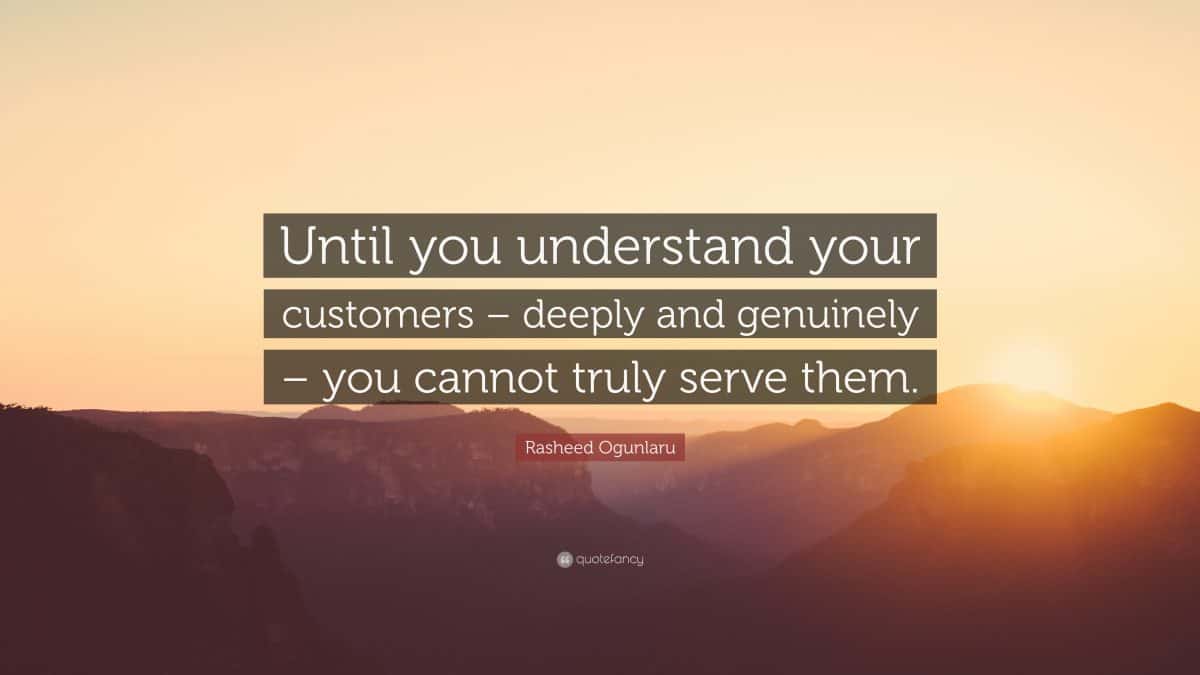The ability to understand and solve your customers pain points is one skill that every business owner and entrepreneur must develop.
Solving your customers problems is what every business tries to do and your ability to do it better than most of your competition, is what keeps you relevant in business.
The customer is always right – That is one statement, which in most cases, spells the difference between a successful business and a not so successful one.
With it in perspective, business owners assume that the customer often knows what he or she wants. The reality, however, is that though your customer are hardly seen as wrong, they may not always be right – They hardly ever know what they truly need.
All that a customer truly wants is to solve one or more customer pain points; it is your duty as a business owner to understand it, and also get it resolved.
You must understand that your customers don’t often care about your products or services, but about the problems you are solving for them – Their pain points.
Your customers tie their loyalty to the value that you provide to them by identifying and solving their pain points and problems. And the customer experience that you give them is, in fact, a big part of what makes them loyal to your brand.
As an entrepreneur, a business owner, a freelancer, or a small business consultant, your marketing efforts shouldn’t only target potential customers. Still, you should also focus on finding ways always to improve your customers’ last-mile delivery. Ensure that their entire experience from your marketing gigs, service delivery, and aftersales support, are all deliberately orchestrated to deliver top-notch customer-centricity.
Your customers tie their loyalty to your value proposition, and the problem-solving journey you take them through is a big part of what makes them loyal to your brand.
When you solve your customer problems, you are not only solving their problems; you are creating an experience that helps to improve your brand’s equity and trustworthiness with your client.
The challenge you have in meeting their needs is how you would identify their pain points; you have to know what their problems are to be able to solve them.
This post is an expose on how you can find and solve your customers’ problems – Solving Your Customers Pain Points
Contents
Understanding Your Customers Pain Points
To understand your customers’ pain points, you must first understand the basic needs common to all customers, regardless of the market, or class. The seven primary needs of any customer are Empathy, Service, Choice, Price, Quality, Action, Appreciation, and Follow-up.
Empathy: Every single customer that passes through your sales process wants you to feel their pains; they need you to understand things from their perspective and be human with your responses to their questions. Empathy is the one skill that every salesperson must-have.
“I’m constantly blown away at how appreciative people are when they get human replies. Years of uncaring or even hostile support experiences have set the bar low for their expectations that they get excited by genuine answers.”
–Micah Bennett, Zapier
Service: Your customers want to feel special, and make them feel special, you must. Customers want excellent service – they expect that you would meet and surpass their needs.
Choice: The need to have a choice to pick from is most pronounced in monetary transactions. As a business owner, you must understand that your customers do not want to be forced to make a decision based on scarcity. Every customer desires the satisfaction derived only through having options. Notwithstanding, customers do not appreciate being overwhelmed with too many similar options – they may end up not buying at all.
Price: Your customers are always seeking prices that match their budgets; some would sometimes go for price over quality. You must ensure that you have a balance of quality and price by giving them lots of shopping choices.
Quality: Most customers need excellent and durable products; they want their product or service to be top-notch. In most cases, customers would not question the price if the manufacturer provides high-quality products, especially when shopping a brand they trust.
Action: Your customers need you to suspend whatever you are engaged with when you attend to them; they need you to act when they need your attention, especially when they have a problem.
Customers want to know that there is always someone ready to act when they need service.
Appreciation: customers want to know that they are appreciated. To build a long-lasting relationship with customers, they have to be understood and appreciated for their individualities. Companies with excellent customer service have customers that outlive their projected customer lifetimes.
Follow-up: You know that you need to follow up with prospective clients to close deals, but you often find that the customers that need your follow up are your existing customers. Customers want you to place that call to find out what their experience of your service or product is.
One sure way to boost your revenues is to leverage effective after-sales follow-up of existing customers – it is a way to turn them into your brand ambassadors.
Recommended: 5 Excellent Tips To Attract New Customers
Understand Your Customers’ Points of View – How They View Their Pain Points

Great customer care involves getting to know your customers so well that you can anticipate their needs and exceed their expectations – MarketingDonut
You can’t effectively serve a customer that you do not understand. And to understand your customers, you must be able to see things from their own points of view – their perspectives.
To understand your customers’ point of view, you have to accept that customers will have different opinions regarding your products or services.
Therefore, as a vendor, the most crucial aspect of your business that you must handle is to ensure that you have a well-trained staff as a customer care representative.
That is your first task as a business owner; A role that you would have to play until you can employ someone to fill in the position.
In your journey as a business owner, you will encounter different types of buyers – buyers that are different from the buyer personas you created.
You will meet the straightforward customers, the impatient customers, and the almost impossible customers. What will stand you out as an excellent business owner or salesperson, is how you understand every one of them.
Recommended: Understanding Product Trends
You are also to understand the problems that are not related to your products or services. For example, you sell human hair, and a client complained about tangles after using the wrong product for wash and conditioning the hair. You should be able to find ways to explain why the products used by the customer damaged the hair, and not that your product was inferior quality.
Identify Your Customers’ Pain Points.
Identifying your customers’ pain points and proffering solutions to their problems puts you ahead of your competitors. Pain points vary and it depends on the type of market that you and your customers operate – B2B or B2C. The importance of identifying your customer’s pain points is to help you learn your customer’s specific challenges and to enable you to come up with a tailored solution to their problems – A win-win for everyone.
In B2C marketing, pain points often involve improving consumers’ finances or level of productivity. In B2B, pain points typically revolve around streamlining internal processes or providing critical operational support – always with an eye on improving the bottom line – Source: BAI
Identifying The Pain points of a B2C Customer
A crucial success factor in marketing is your ability to learn what challenges your customers intend to solve with your product or service, and then fine-tune your value proposition (what you offer) to provide an excellent solution.
So many of us have had issues while using some products and services, we didn’t really know how to relate those issues to the vendors, but the vendors figured out what the problems were and regained our faith in their products or services. If you are a business owner, a sales agent, or you interface with consumers at any point in the customer value chain, it is crucial that you learn to identify problems even when the customers cannot properly explain.
Being equipped to identify your customers pain points and proffering solutions makes you a super-brand. You can achieve this by doing the following:
- Study The Industry
- Talk To Customers
- Ask Relevant Questions
- Act on Feedback and Reviews
4 Ways To Solve Your Customers Pain Points
1. Study The Industry
To learn about consumer pain points, it’s important to study the industry which you are interested in. This can be accomplished in many ways. Some combination of research in the following areas can give you a good idea of the current pain points trying to be addressed in your niche.
- Read trade publications
- Join trade associations
- Attend conventions and seminars involving your industry
- Follow thought leaders in your industry via social media
Doing all the above will quickly give you a picture of pain points that have been addressed, those companies are currently trying to address, and insight into possible pain points in the near future.
It is crucial to study the industry which you are interested in to learn about common pain points of consumers there, and you accomplish that in many ways. A careful study into the under listed areas can give you a good idea of such common pain points that customers try to address.
- Join trade unions
- Read trade newsletters and publications where available
- Attend industry-specific conventions and seminars
- Follow thought leaders and influencers in your industry
Doing all the above will help you get a feel of some pain points that are common in your industry: those that have been addressed, the companies that addressed them, who is doing what, etc. Above all, networking with other players in your industry will give you insight into possible pain points in the near future.
Recommended: How To Improve Sales Through Excellent Customer Service
2. Talk To Customers
Another sure way to understand your customers pain points is to call your customers and have a short interview with them. During the call, avoid leading (yes or no) questions to enable you to gain insights into the customers’ problems. A simple Yes and No answer would leave you in the dark on why they chose their answers.
3. Ask Relevant Questions
Maximize open-ended questions to give room for the customer to say precisely how they feel about the problems. Enure to ask service impact-focused questions to find out if your products or services have been meeting their needs and ask of ways you may better serve them. Such questions could be:
- How do you see your needs changing post-COVID-19 pandemic?
- What are your necessities from this deal should it happen?
4. Act on Feedback and Reviews
One thing many businesses have in common is asking customers for reviews they don’t review or use. When you ask for reviews, endeavor you create time to go through them, and be particular about the negative reviews. The negative reviews show there are things you are not doing right, so work on finding the roots of your customers’ problems.
Remember that reviews taken seriously can give your business a new sense of direction, help you to reposition your business, and make you more strategic about content marketing.
Identifying The Pain points of a B2B Customer
If your prospects don’t have business pain, they have no need. And without need, there’s no hope for a sale. It’s up to salespeople to ask effective sales questions and uncover business pain as quickly as possible.
Conduct qualitative research by asking your customers essential questions:
- Ask them to explain their problem the best way they can.
- Ask when the problem started and if the problem had occurred before.
Use their answers to the questions asked to identify the root cause of their problem. Note that it is fine not to have immediate responses to their inquiries, but take time to provide the right solutions. It’s better to take longer than to dish out the wrong answers quickly.
Conclusion: Customers are more likely to stick with the business they have built a good rapport with than trying out other solution providers. Customers understand that problems are a part of every business; they come to you because they need solutions to their pain points and do not care about the processes you take to provide adequate solutions – they just want to ease their pains. And their loyalty, therefore, lies with the provider that takes conscious steps towards consistently providing them with excellent solutions when needed.
Suggested


























Thanks for the information
This is apt!!!!
Patience,a good listening hear and gentleness,is all you need to extort more from customers.
Don’t be too harsh and impatient
Thank you for sharing with us, I conceive this website truly stands out : D.
You are a very clever person!
I was just searching for this information for some time. After six hours of continuous Googleing, at last I got it in your site. I wonder what’s the lack of Google strategy that don’t rank this kind of informative websites in top of the list. Generally the top web sites are full of garbage.
Hi there, You’ve done an excellent job. I will definitely digg it and personally recommend to my friends. I’m sure they will be benefited from this web site.
Hey there just wanted to give you a quick heads up and let you know a few of the images aren’t loading properly. I’m not sure why but I think its a linking issue. I’ve tried it in two different browsers and both show the same outcome.